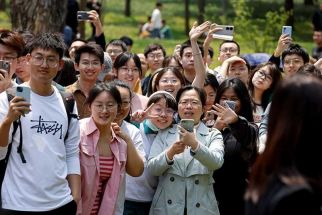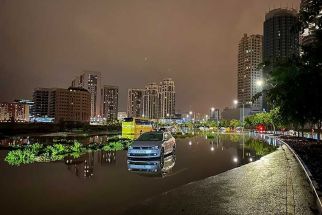‘Tunganga na naman kami:’ Recovering Boracay workers’ livelihood suffers anew amid COVID-19 travel ban
BORACAY, Philippines — The workers of Boracay are just recovering from the income loss when the island was closed to public for six months in 2018 but they are now facing another threat to their livelihoods amid the COVID-19 outbreak.
Boracay is the top tourist destination of the country, with tourism as the main livelihood of its residents.
Just more than a year since the island reopened, it saw another huge drop in tourists after the Philippine government banned foreign travelers from China late January to prevent the spread of the fatal novel coronavirus that originated from Wuhan.
It also expanded the travel restrictions to China’s special administrative regions, Hong Kong, Macau and Taiwan as well as the South Korean province of North Gyeongsang.
Mid-February, the government lifted the travel ban on Taiwan.
Because the island’s tourism industry banks on China and South Korea as among its top source markets, these businesses and independent workers are again experiencing income losses.
Business slowdown
Nining Mamua, a vendor at a retail store in Station 2, said the recent COVID-19 outbreak is taking a toll on their daily income.
“Matumal. Super talaga. Simula nung wala nang Chinese at saka Korean wala nang pumapasok. Takot na kasi sila baka mahawahan sila dito ng coronavirus,” she said in an interview with Philstar.com.
“Wala na, wala na ‘yung iba. Wala nang trabaho lahat. Minsan ‘yung iba nagbabawas na ng tao," she added.
The vendor of 10 years, said their store use to earn P20,000 a day but they are only currently earning P1,000 following the travel ban.
Calamity Survival band, a group of musicians playing at a bar and restaurant, said the absence of Chinese and South Korean tourists is evident. They said it used to be traffic along the commercial areas of the island but now some of the establishments have closed down due to lack of tourists and there are no more traffic.
READ: Show must go on: How Boracay's closure created the Calamity Survival Band
Even tourist Carlos Enriquez from Los Angeles, California said he also noticed the absence of foreign tourists.
“We are surprised and a little bit sad. Happy because it was little better— the traffic is better, but I think there are less tourists around this time compared to last year. There are a lot Filipino tourists around the area and some Caucasians but lesser from Asia especially Chinese and Koreans maybe because of the COVID-19,” he said.
Rosa, a hair braider in Boracay beach for 20 years now, said with the absence of these tourists she is also experiencing a business slowdown.
“Lugi na nga kami. Dati mas marami kasing kita dahil sa Chinese. Ngayon wala na magmula noong nag-coronavirus,” Rosa said, adding that she also rarely has a Filipino customer.
The hair braider said she now issues discount to attract more clients but these are still enough.
According to e-tricycle driver Ramil Macahilig, his profit during the island closure and during the travel ban is almost the same. He added that the effect of COVID-19 outbreak may be worse.
“Parang parehas lang kinikita namin. ‘Yung closure kasi may tao pa naman dito saka hindi tumatakbo lahat ng sasakyan noon. Ilan lang kaming bumabiyahe. Sa ngayon kasi lahat bumabyahe e,” Macahilig said.
“May turista pa naman kaso mangilan-ngilan."
Macahilig said he is happy to take home P300 to P400 after a whole day of servicing trips on the island.
The Department of Tourism plans to mitigate the economic impact of COVID-19 outbreak with domestic tourism.
The perils of Luzon-wide quarantine
However, President Rodrigo Duterte last week imposed a month-long community quarantine over Metro Manila and later on an enhanced community quarantine expanding it over the whole Luzon.
Under this umbrella measure, domestic flights to and from Luzon are halted. Local carriers also suspended operations amid the quarantine.
These concern workers who are still recovering from the island’s closure.
Boatman Anjo, who works as a guide for water activities on the island, said the Metro Manila lockdown may hit tourism businesses bad.
“Tunganga na naman kami. Nagre-recover pa nga lang e,” he said.
Macahilig also expressed concerns on food supply.
“Saan pa kami kukuha ng supplies? Almost lahat ng supply dito dadaan ng Maynila,” he asked.
Still, the e-trike driver’s concern is his work.
“‘Umaasa lang naman kami sa turista e. 'Pag walang turista. Wala kaming kita,” he said.
Despite this, Macahilig said he doesn’t have any back up plan amid the travel ban.
“’Pag nag-iba kami ng hanap buhay wala rin siguro e,” the driver added.
During the island closure, members of the Calamity Survival Band were prompted to change jobs.
RELATED: Changing roles: How some residents are coping with Boracay closure
This time, however, the band said the show must still go on for them.
“We’ll just keep on playing just like noong sarado 'yung isla. Nakita niyo naman wala halos kaming kliyente dito pero tumugtog lang kami nang tumugtog. ‘Pag pinatugtog kami ng boss namin… depende sa boss namin,” Dean Santa Maria, the band’s vocalist and keyboardist said.
Early February, Pacific Asia Travel Association chair Roberto “Bob” Zozobrado said hotel occupancy in Boracay went down and some tour operators have been receiving cancellations amid the outbreak.
“Boracay specially suffered a lot during Chinese New Year. All those Chinese that go there every New Year nawala… All our hotel members ng Boracay pleading for help,” he said in a recent chance interview.
In view of this, Tourism Undersecretary Arthur Boncato last week said the business owners have slashed down prices of hotel accomodations and tour packages.
He said Boracay’s daily international tourists is “down to almost 1,000 or around 80% starting March. The island’s daily carrying capacity is 5,600.
How the tourism industry plans to recover
The DOT earmarked P6 billion to help mitigate the economic impacts of COVID-19.
At least P85 million of which will be allocated to the training on COVID-19 orientation, preparedness, response and protocols for industry stakeholders.
The agency’s infrastructure arm, Tourism Infrastructure and Enterprise Zone Authority, also launched a P14 billion tourism development program “to prepare the tourism sector for a quick recovery once the COVID-19 pandemic is over.”
“This crisis will pass but our sector is badly hurt. We must find ways to shorten the tourism industry’s recovery path while generating jobs in the meantime,” Tourism Secretary Bernadette Romulo-Puyat said Tuesday.
- Latest
- Trending































